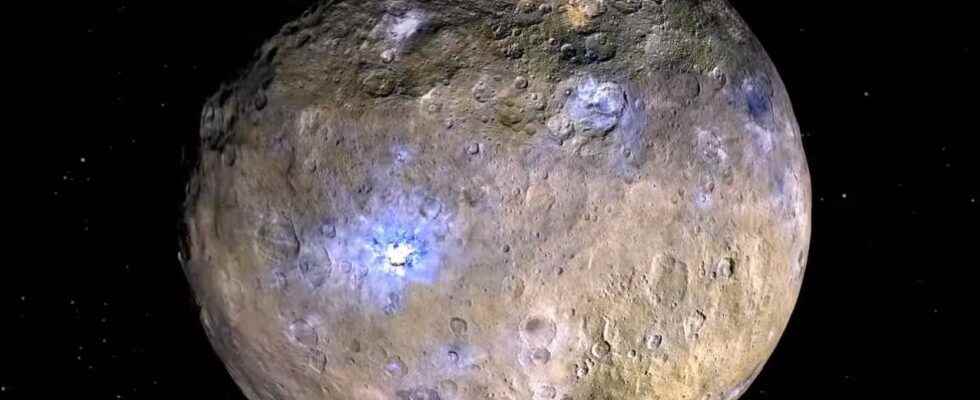You will also be interested
[EN VIDÉO] Dawn is about to probe the mysteries of Ceres After observing Vesta, the Dawn probe is now orbiting the dwarf planet Ceres, the most massive body in the asteroid belt. Here is a video preview of his journey.
After a overview about a year from Vestathe Dawn probelaunched by NASA in 2007, was placed in orbit around Ceresa dwarf planet of the main belt – asteroid belt located between the orbits of Mars and Jupiter. With a diameter of about 950 km, Ceres has a spherical shape, unlike the asteroids that accompany it in its orbit, and is probably differentiated. The study of this dwarf planet could, among other things, help scientists to better understand the processes at work during the first phases of the history of our planet. Solar system.
Numerous craters revealing the entrails of Ceres
After the probe flyby dawn around Ceres, planetologists have been able to discover a frozen, heavily cratered world. It is in one of these craters, named Urvara, that a team of German and Indian scientists thinks they have set up light past geological activity, subsequent to the formation of the depression.
It is thanks to high resolution images resolution (less than 3 m per pixel) of this crater 170 km in diameter, captured by the Dawn probe, that scientists have come to this conclusion. They managed to identify several distinct geological structures, such as a 25 km long and 3 km mountain range located in the central region of the crater, or areas with remarkably smooth surfaces, others dotted with numerous small depressions.
To better understand the chronology of the processes that led to such formations, the team of researchers based themselves on the concentration and size of the craters present in each zone, with the aim of determining their ages: on the principle , the older a surface, the more cratered it is; thus, a younger surface will have fewer craters than an older surface. Coupled with modeling bombardment rates throughout the history of our Solar System, crater counts have dated the formation of the Urvara crater to -250 million years ago, while the geological structures that dot it appear to have formed sometime 100 million years later, testifying to a geology active after the formation of the crater.
Deposits of salts and organic compounds in the crater?
But the scientists do not stop there: thanks to the data collected by the spectrometer VIR (Visual Infrared) embarked on the Dawn probe, they were able to form an idea of the composition of the bottom of the crater, identifying for example salt deposits as well as deposits of organic compounds. Although such deposits have already been observed in other craters of Ceres (like the Occator crater), this is the first time that such a combination has been observed.
The presence of such compounds in the Urvara crater raises several questions, and leads scientists to formulate several hypotheses. On the one hand, the impact at the origin of the formation of the crater could have excavated salty materials initially present inside the planet towards the surface. Others argue, on the contrary, that these salts come from a mixture resembling brine (water with a high salt content), which would have reached the surface via cryovolcanic processes.
Although the question is still debated, the presence of salts and organic compounds in the crater supports the idea that Ceres is a dwarf planet with active geology. This activity could be linked to the existence of an ocean under the crust who could, despite the great distance that separates Ceres from Sunremaining today partially liquid under the effect of high salt concentrations, acting as antifreeze.
Support your independent scientific media: discover our subscription formulas!
4 good reasons to subscribe to Futura on Patreon:
- A site without any advertising from 3.29 euros per month.
- It is without commitment.
- Access to priority content, in preview, just for you.
- You support our business in the best possible way. A real motivation for us!
Interested in what you just read?
